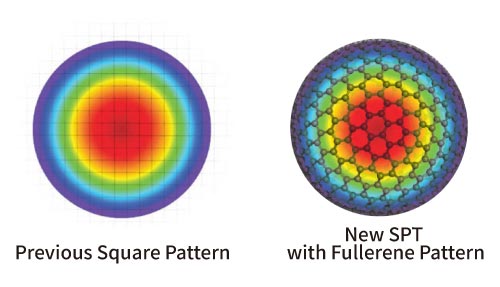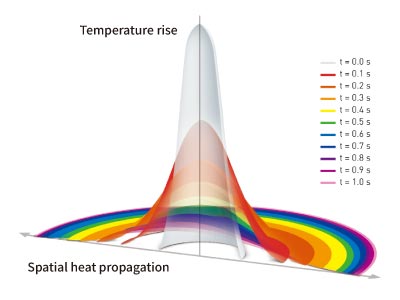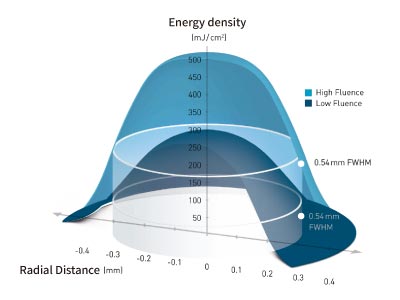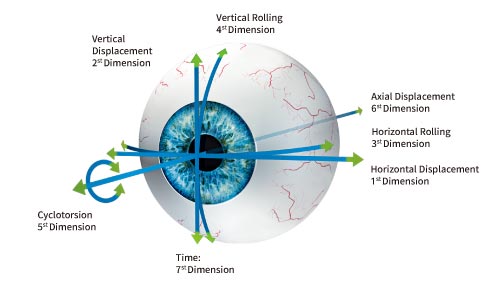
Revolutionary Technology
Schwind Amaris 1050RS
Schwind Amaris 1050RS,Medical Design Excellence Awards Winner

Innovative Solutions
SmartPulse (SPT)
Smart Pulse Technology (SPT) uses a sophisticated geometric model based on a fullerene structure. This three-dimension model describes the curvature of the cornea very realistically, and the fullerene structure makes it possible to position the pulses more closely than before. This is particularly marked at the periphery of the cornea. The latest measurement and analysis methods also help make optimal use of the spot geometry. The totality of the innovations in SPT results in a very smooth corneal surface.

Intelligent Thermal Effect Control (ITEC)
ITEC ensures that the laser pulses are distributed in a thermally-optimised, dynamically-adapted way, which gives the individual position on the cornea sufficient time to cool off. The following pulses can therefore be directed at an already cooled location. Studies using an infrared thermographic camera have proven that the corneal tissue only heats up minimally, even at high ablation speeds.

Automatic Fluence Level Adjustment(AFLA)
Researchers at SCHWIND have developed an algorithm that ensures an ideally balanced ratio between the total number of laser pulses and the energy delivered. About 80% of the ablation is performed at a high-fluence setting. For the fine modelling, the remaining 20%, AFLA automatically switches to a lower fluence. The result is an optimal smoothing of the corneal surface. Through the extremely small beam size and Super-Gaussian beam profile, you achieve an exceptionally smooth ablation.

7-Dimensions Eye-Tracking
The innovative SCHWIND AMARIS 1050S combines speed and precision in new dimensions. The 1050 Hz eye tracker actively compensates for every eye movement in seven dimensions, and offers an unprecedented level of safety.

7D
Dimension:Time
6D
Dimension:Axial Displacement
5D
Dimension:Cyclotarsian
4D
Dimension:Vertical Rolling
3D
Dimension:Horizantal Rolling
2D
Dimension:Vertical Displacement
1D
Dimension:Horizantal Displacement
| Differences at a glance | 1D | 2D | 3D | 4D | 5D | 6D | 7D | Pupil and limbus tracking |
|---|---|---|---|---|---|---|---|---|
| AMARIS| 1050RS |
||||||||
| AMARIS|750S | ||||||||
| WaveLight EX500 Excimer Laser |
Statements
Prof. Dr. Dr. Theo Seiler from Germany
Schwind Amaris 1050RS manufactures the fastest excimer laser in the field which guarantees a stable hydration of the cornea during the laser treatment and it offers an extraordinary level of customization – for patient and for surgeons as well. Surgeons can select much better what the patient really needs, for example doing wavefront guided treatments without correcting all aberrations but only special corrections which the surgeon feels are more important for good vision than others and thereby saving tissue by this procedure.
Dr. Jerry Tan, MD from Singapore
The Amaris laser includes SmartPulse technology, what basically means, that it is smooth over the corneal surface. This is especially important, when you are doing treatments with what is called transepithelial PRK. TransPRK originally is done in a two-step procedure by other lasers. Smart transPRK removes the epithelium and treats the corneal shape all in one step. This makes it very simple. There is no hyperopic shift, there is no inconsistency in the myopic correction. SmartSurf is also very, very good for treatment of difficult cases. Cases with scars, cases with irregular corneas, and SmartSurfAce guided by corneal wavefront treatment is the best for treating difficult cases.
Dr. David Lin, MD from Canada
The recovery is even faster than LASIK on the first day. After two days, patients can read phones, check computer monitors and do many other things. After 4-5 days, when the contact lenses come out, the patients can drive again their car without glasses and they easily achieve 20/40 or better. So the wow effect has come back to refractive surgery. The patients are happy, the surgeons are happy because there are no complications from LASIK or flaps or lenticule. It’s truly stressless surgery–a paradigm shift in refractive surgery. Smart transPRK is the way to go.
Dr. Marcelo Fonseca, MD from Brazil
I saw patients with pain and discomfort after the PRK procedure, so I changed to LASIK surgery. I had to do with many complications like incomplete flaps, button holes or dislocated flaps. With Smart transPRK, I can offer my patients a real no-touch procedure with much less pain especially using Mytomicin C, a very smooth corneal surface and a fast recovery, especially of visual acuity. SmartSurfAce, at least in my practice, can compete with LASIK. We are very happy with it.
Dr. Diego de Ortueta, MD from Germany
We're changing more the cases from LASIK to Smart transPRK, now in my clinic we have ninety percent of the cases performing Smart tranPRK. And why i'm so happy? Because the resource are very predictable and the safty is very high, we observed at the fourth day of the surgery as most of the cases have a visual acurity of run abount 20/25 after four day after the surgery the day they take off the contact lens. In my clinic, when the patient comes to us, we offer both(LASIK and Smart transPRK) to them. Although that we say them that maybe takes visual recovery maybe one or two days longer than LASIK, 90% of our patients choose Smart transPRK because of its safety.
Dr Jose Miguel Varas, MD from Ecuador
We're not only have optimal optical outcomes but we could add several groups of excluded patients to our practice. Those with thinner corneas, patients without keratoconus but with unusual topographies, patients with fear of the mechanical part of the treatment that's the macro peritoneum, those patients who didn't want to have a blade into their eyes and it was very useful to those uncooperative patients because there is no touch involved. Thanks to the new ablation pattern called Smart Pulse where the ablated surface achieves a very very improvement in the smoothness of the surface. Patients achieved a visual acurity recovery between 25 and 20/30 in the frist and second days.
